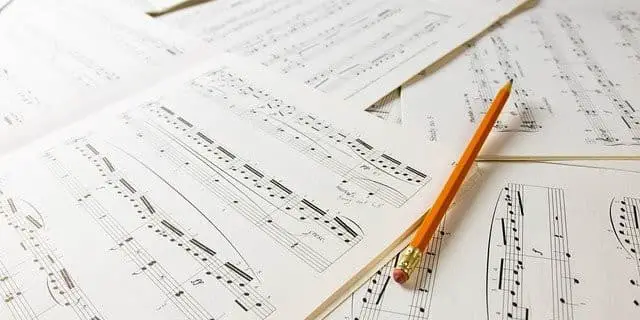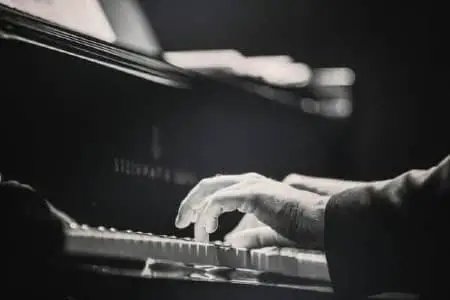- Home
- Piano Scales
- Minor Piano Scale
The 3 Minor Piano Scale Patterns
This article may contain compensated links. Please read the disclosure for more info.
In this lesson, we'll take a look at the Natural, Harmonic and Melodic minor piano scale patterns and learn just how they're different from the major scale. We'll also dig into the theory and discover why we have types of 3 minor scales.
Natural, Harmonic & Melodic Minor
Tip
Every serious pianist needs a piano scale book as a reference. Click here to see my most recommended piano scales book.
The Natural Minor Piano Scale
The natural minor scale, also called Aeolian mode, can easily be found on the white keys on the piano by starting from the note A. The natural minor piano scale pattern is "ready" in A minor, see it here:

Starting from A, the pattern for a natural minor scale is (W=whole step, H= half step):
W - H - W - W - H - W - W
If you start from another note, you'll have to keep the exact pattern of whole and half steps between the keys by adding the necessary sharps or flats.
There are two more variations of the minor pattern. One is called harmonic minor, and the other is called melodic minor. You could say that they're actually the same basic pattern as the natural minor - just alternating the intervals at the 6th and the 7th steps.

The Harmonic Minor Piano Scale
In harmonic minor the 7th step is raised 1/2 step higher, both going up (ascending) and down (descending):

The Melodic Minor Piano Scale
In melodic minor, the 6th and the 7th step is raised 1/2 step when the minor piano scale is played going up (ascending), but when it goes down again (descending) it lowers them, or simply; it becomes natural again.
Ascending:

Descending:

Why 3 Types of Minor Scales?
Now, why confusing things like that? Why isn't there just one minor scale pattern as there is only one major scale pattern?
In western "classical" music up to approximately the 1600's, it was common to use the 7 musical scale modes. Two of those modes; the Ionian and the Aeolian, are what we now call Major and Natural minor.

During the Baroque and Classical eras, it became more and more popular to use mainly major and minor tonalities.
Simplicity! Clarity! This was the beginning of the Age of Enlightenment, after all!
No more of the confusing harmonies and modes, that were used during the Renaissance, with complicated Polyphony (many "melodies" interwoven), and stuff!
Homophony (melody and accompaniment by chords) was all the rage! Music should be either happy or sad- nothing in between- and have simpler, more clear melodies with accompaniment, not four or five equal melodies weaving around each other.
How else were people supposed to know what to cry or sing along with? :)

Imagine, even J. S. Bach, with his marvelous compositions like fugues (composed in polyphonic style), was considered by many contemporaries to be a really old-fashioned Big Wig.
Out with the old- in with the new! The new invention of the Opera undoubtedly had something to do with the popularity of major and minor modes. People had to know when to laugh and when to cry! :)
But combining the older melodies made from the "church" modes with minor chords just didn't sound so good...
So, altering the 7th step, and even the 6th sometimes, was a compromise to solve the dilemma when adding harmonies (chords) to the melodies.
This is where the name "harmonic" minor comes from. The minor scale is used to harmonize the melodies.
And by raising the 7th step on a minor scale, you also get this feeling of a strong pull, back to the first (or last) note. In this way, you get a stronger sense of tonality- or a tonal center.
It's interesting to note that the minor scale is quite interesting in that it has a lot more "flexibility" than the major scale.





